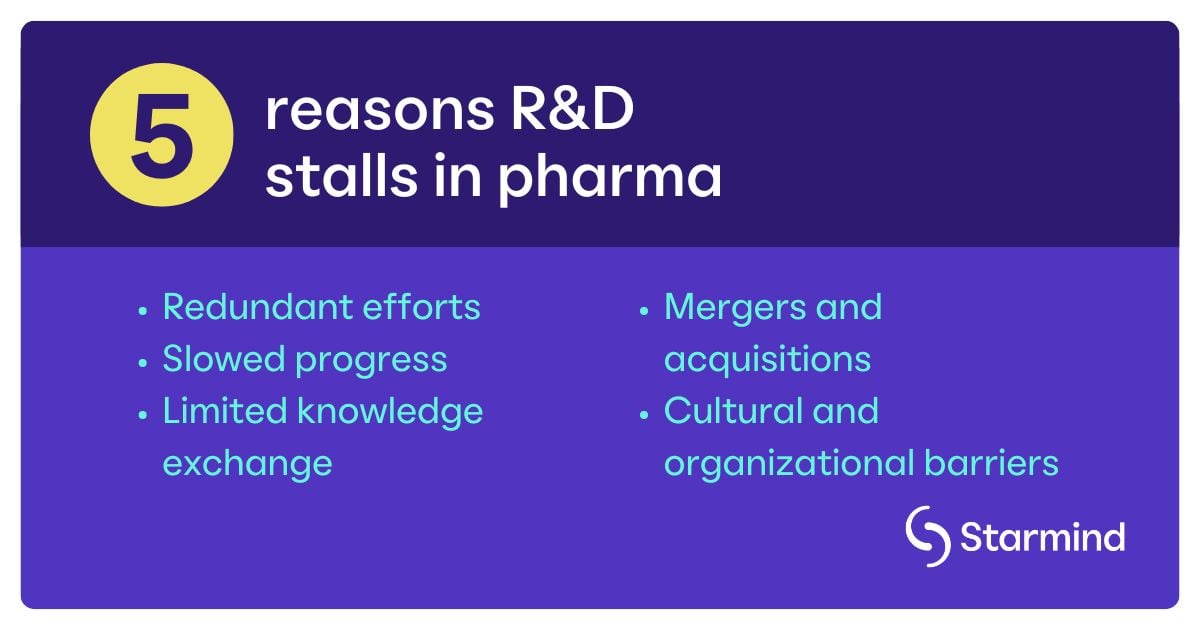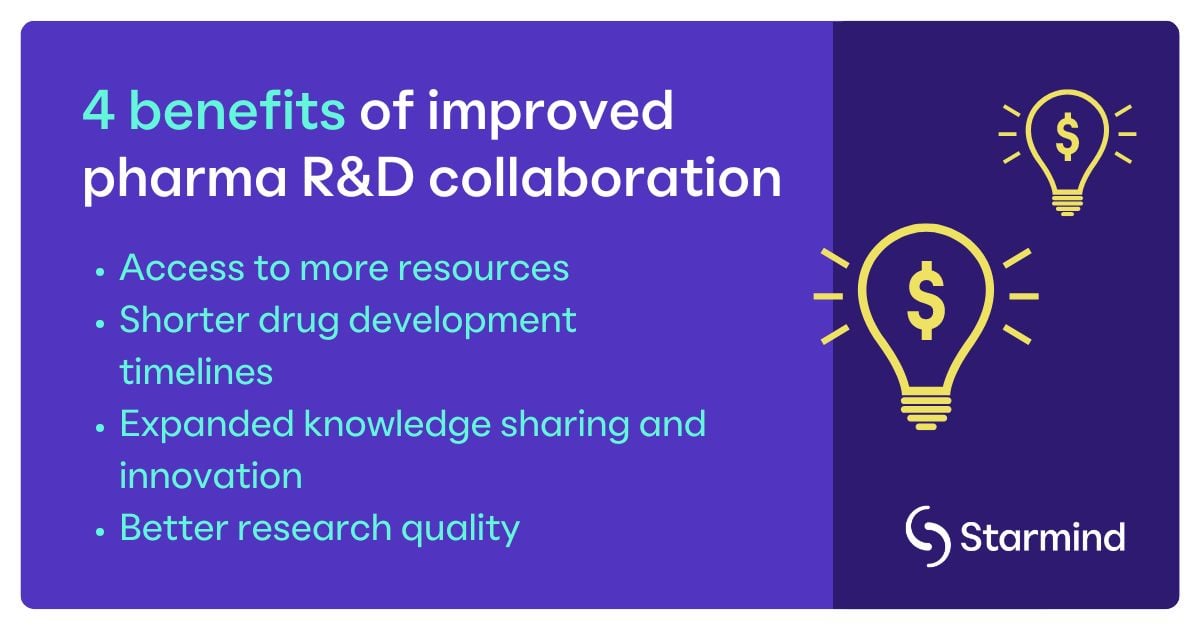Contents
Pharmaceutical companies can transform human health while realizing substantial financial returns when they introduce live-saving drugs and treatments. However, discovering, developing and delivering these drugs can be costly and complex, with a high risk of failure. To innovate, pharma R&D teams need meaningful ways to collaborate internally.
Unfortunately, pharmaceutical research and development (R&D) is facing a productivity crisis. The industry's inflation-adjusted spending on R&D climbed by 44% from 2012 to 2022. But the increase in novel drug approvals in the United States hasn’t kept pace. R&D teams need better ways of working together if they want to pick up the pace.
Learn what’s preventing pharma R&D collaboration, what companies stand to gain from working more closely together and how artificial intelligence can transform the industry’s ability to collaborate and innovate.
What causes poor R&D collaboration?
Pharma research and development can be a complex endeavor spanning multiple teams across geographies. Here are some of the common challenges when trying to align R&D teams within an organization.

Redundant efforts
A common occurrence in siloed environments is redundant work, where teams in different locations unknowingly focus on similar problems or duplicate experiments. This creates inefficiencies and wasted work. For instance, if two teams don’t communicate and wind up developing similar drug-screening processes, the company effectively doubles its R&D spend for the task. Worse still, these competing solutions could spark debate over which is best, further delaying progress.
Inefficient processes
You want R&D teams to have autonomy and initiative, but you don’t want them setting their own strategy or failing to coordinate with other stakeholders. Without effective collaboration, teams could be working toward different goals, at different speeds and with varying efficiency. This can delay the overall project timeline, as some teams are stuck waiting on other groups to complete their work first.
Limited knowledge exchange
Silos inherently restrict the flow of information, which makes it difficult to share knowledge that's vital for innovation. When teams don't share their successes and failures, the entire organization misses out on learning opportunities that could lead to critical advancements or help them avoid common mistakes.
Mergers, acquisitions and spinoffs
Mergers and acquisitions can be disruptive across the workforce, and particularly to R&D teams that suddenly experience changes to their culture, budgets, personnel and technology. The post-M&A integration process can be difficult. R&D departments can suffer from lost productivity due to consolidation, overlap in project scopes, confusion and duplication of efforts.
Cultural and organizational barriers
Cultural differences across business units or geographies can influence work styles, communication and decision-making processes. While a diversity of perspective can fuel innovation, unaddressed differences in organizational culture can also create misunderstandings and inefficiencies that hinder R&D work.
Additionally, organizational hierarchies and bureaucracy can inhibit teams from being agile and communicative — stifling innovative ideas before they can be fully explored.

4 benefits of improved collaboration in pharmaceutical R&D
Even the best pharma R&D teams will struggle to consistently generate breakthrough drugs and treatments by themselves. Here are some of the benefits of improving collaboration.
Access to more resources
New drugs can cost billions of dollars to develop. By collaborating internally and even externally, pharmaceutical companies can pool their resources, share costs and bring together efforts on similar tracks. Sharing data and results during the preclinical research stage, for example, can lead to more efficient and cost-effective clinical trials with humans.
One example of companies combining their resources is Pfizer and BioNTech in their work on a vaccine for COVID-19. Within days of the pandemic declaration, these companies were combining BioNTech’s mRNA technology and Pfizer’s global manufacturing capabilities. This partnership led to vaccine development within months instead of years.
Shorter drug development timelines
Bringing drug candidates to market can take many years, and anything that reduces that timeline without compromising efficacy and safety is a massive advantage. When teams use AI-powered collaborative tools for drug development, they can leverage each other's strengths and expertise to accelerate the process.
For instance, sharing data from early-stage research can identify potential roadblocks early, ultimately accelerating the drug development timeline and preventing time wasted on faulty or less-promising efforts.
Expanded knowledge sharing and innovation
When teams work together, they tap into a wider range of expertise and perspectives that can speed up problem-solving. This interactive environment creates an innovative culture that pushes the boundaries of what’s scientifically possible.
For example, Roche needed to connect its global team of more than 100,000 employees to share expertise and collaborate on R&D activities. The company leveraged Starmind’s AI-powered expertise directory to instantly connect researchers to specific people within the organization with the most relevant and useful expertise. By 2023, the solution had expanded from 1,000 to nearly 9,000 users, saving around 91,000 employee hours that were previously spent on searching for information and internal experts.
Better research quality
By sharing information and coordinating efforts, teams can avoid duplicating experiments, reduce errors, and improve the overall quality and effectiveness of research. This collaborative approach promotes a more systematic and rigorous approach to drug development, leading to safer and more efficacious treatments.
How to drive collaboration and innovation with AI
AI helps to break down barriers between teams, increase the flow of knowledge and expertise, and accelerate innovation and product development. Some of these AI use cases make collaboration easier, while others enable ongoing access to key information. Here are a few ways to use AI in your pharma company for better collaboration.
Centralize your business data
Centralizing data into a constantly updated system allows R&D teams to access real-time information and maintain continuity across all stages of drug development. R&D teams can act with speed and confidence knowing that they’re accessing (and contributing to) the latest data.
Centralizing your data also makes analysis easier, as you’re applying advanced data science techniques, such as predictive modeling and simulation, to a unified data set. R&D teams can forecast outcomes, optimize processes, and refine drug formulations before trials begin, all without worrying about missing or incomplete data.
Empower global collaboration
Because the pharmaceutical industry is global, language barriers can complicate collaboration. This is where AI-powered translation tools can improve everyone’s access to key reports, emails and even real-time conversations. AI can also help R&D teams adapt to industry jargon and terminology, increasing the accuracy and relevance of translations.
For example, Starmind’s automatic translation feature allows team members to interact and access vital information in their preferred language. This tool automatically translates all forms of communication on the fly, from simple queries to complex technical documents. Every team member can fully participate and collaborate, even if they don’t speak the same languages as their colleagues.
Starmind also provides visual indications of translated content and the original language, giving additional context so users can interpret and verify the translation’s accuracy.
Learn from past research
Global R&D teams have conducted countless experiments and trials, with a mixed record of success. But even the unfavorable outcomes offer valuable lessons — if only your team is aware of this data and can access it.
AI systems can sift through vast amounts of experimental data, R&D project outcomes and external research findings to help your current projects shine. Machine learning models can provide recommendations on adjusting methodologies, compounds or trial designs to avoid common mistakes.
For example, a pharmaceutical company could use AI to analyze data from a series of failed drug trials targeting Alzheimer's disease. The AI system can identify common factors across these trials, such as participant selection criteria or dosing strategies. With this AI-powered insight, the R&D team can adjust its approach going forward — helping it isolate any remaining factors.
Share internal expertise
AI-powered technologies are particularly adept at scanning vast amounts of data. The next evolution is using that data to identify internal subject-matter experts who can help employees verify information or get additional context.
These tools analyze your repository of corporate data, including past projects, published research and experimental results to suggest potential collaborations. An AI-powered expertise directory, for example, provides a framework for your company’s data and expertise. Rather than simply store this information, these AI tools map out your organization’s skills and knowledge, allowing project leaders to connect with the right experts instantly.
Improve decision-making
Many AI tools offer predictive analytics features that can forecast trends, consumer preferences, and potential research breakthroughs. AI-powered tools can also dynamically adjust to new data inputs, allowing teams to continuously refine their strategies as new information becomes available.
This is especially crucial in pharma R&D, where the early detection of viability or potential failure can lead to millions of dollars in R&D cost savings and reduce the time to market.
Automate routine tasks
AI systems can handle a variety of routine functions such as data entry, standard data analysis, and even initial drug-interaction assessments, all with higher speed and accuracy than manual processes.
This automation increases operational efficiency and reduces the risk of manual errors. This gives scientists more time for problem-solving and research activities that are directly related to drug development.
Unlock your team’s potential
AI can jump-start your pharma R&D team’s potential by giving them powerful tools to augment their human creativity and expertise. As your researchers, scientists and business leaders strive for medical breakthroughs and new therapies, Starmind’s AI-powered Expertise Directory seamlessly connects these individuals wherever they’re located.
Starmind helps you harness the collective intelligence of your organization by making it easier for team members to find the right expertise when they need it. Want to see Starmind in action? Watch this webinar to learn how Roche uses Starmind to improve collaboration.



